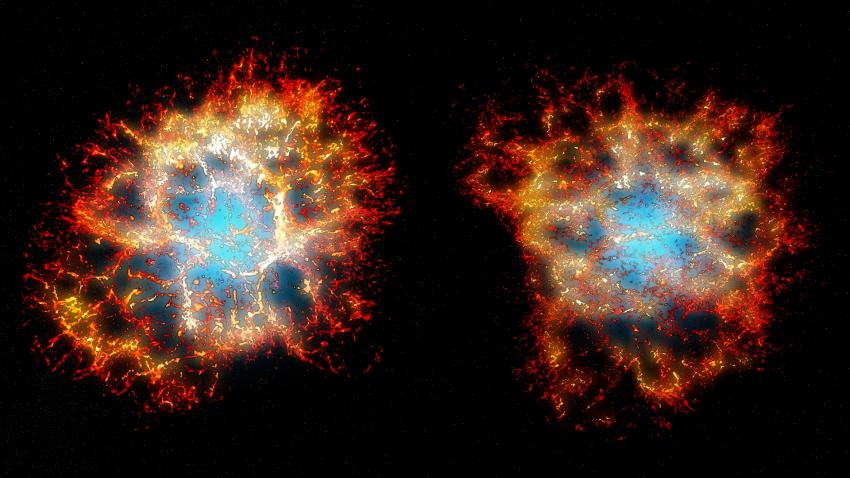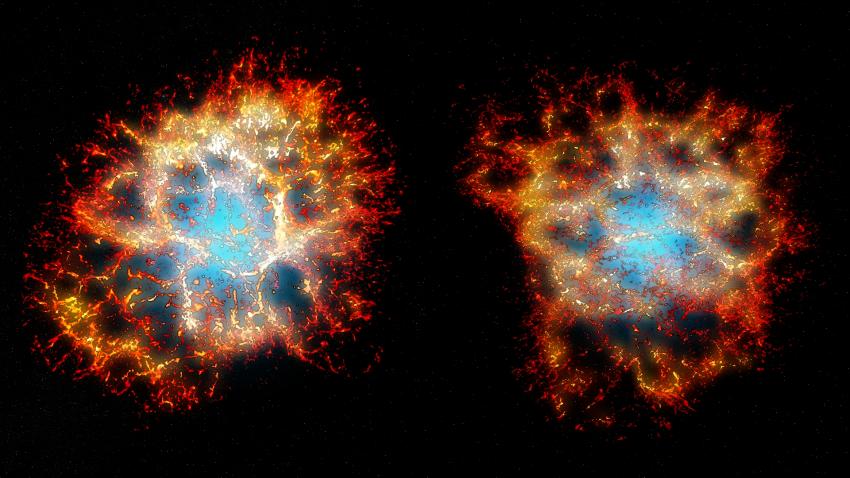A unique ‘heart-shape’, with wisps of gas filaments showing an intricate honeycomb-like arrangement, has been discovered at the centre of the iconic supernova remnant, the Crab Nebula. Astronomers have mapped the void in unprecedented detail, creating a realistic three-dimensional reconstruction. The new work is published in Monthly Notices of the Royal Astronomical Society .
The Crab, formally known as Messier 1, exploded as a dramatic supernova in 1054 CE, and was observed over the subsequent months and years by ancient astronomers across the world. The resulting nebula - the remnant of this enormous explosion - has been studied by amateur and professional astronomers for centuries. However, despite this rich history of investigation, many questions remain about what type of star was originally there and how the original explosion took place.
Thomas Martin, the researcher at Université Laval who led the study, hopes to answer these questions using a new 3D reconstruction of the nebula. “Astronomers will now be able to move around and inside the Crab Nebula and study its filaments one by one,” said Martin.
The team used the powerful SITELLE imaging spectrometer on the Canada-Hawaii-France Telescope (CFHT) in Mauna Kea, Hawaii, to compare the 3D shape of the Crab to two other supernova remnants. Remarkably, they found that all three remnants had ejecta arranged in large-scale rings, suggesting a history of turbulent mixing and radioactive plumes expanding from a collapsed iron core.
Co-author Dan Milisavljevic, an assistant professor at Purdue University and supernova expert, concludes that the fascinating morphology of the Crab seems to go against the most popular explanation of the original explosion.
“The Crab is often understood as being the result of an electron-capture supernova triggered by the collapse of an oxygen-neon-magnesium core, but the observed honeycomb structure may not be consistent with this scenario,” Milisavljevic said.
The new reconstruction was made possible by the ground-breaking technology used by SITELLE, which incorporates a Michelson interferometer design allowing scientists to obtain over 300,000 high-resolution spectra of every single point of the nebula.
“SITELLE was designed with objects like the Crab Nebula in mind; but its wide field of view and adaptability make it ideal to study nearby galaxies and even clusters of galaxies at large distances,” said co-author Laurent Drissen.
Supernova explosions are among the most energetic and influential phenomena in the universe. Consequently, Milisavljevic adds: “It is vital that we understand the fundamental processes in supernovae which make life possible. SITELLE will play a new and exciting role in this understanding.”
Media contacts
Dr Morgan Hollis
Royal Astronomical Society
Mob: +44 (0)7802 877 700
press@ras.ac.uk
Dr Robert Massey
Royal Astronomical Society
Mob: +44 (0)7802 877 699
press@ras.ac.uk
Science contacts
Dr Thomas Martin
Université Laval
Quebec City
Canada
thomas.martin.1@ulaval.ca
Dr Dan Milisavljevic
Purdue University
Indiana
USA
dmilisav@purdue.edu
Dr Laurent Drissen
Université Laval
Quebec City
Canada
ldrissen@phy.ulaval.ca
Image, video and captions
This 3D reconstruction of the Crab Nebula is made of 406,472 individual points where nebular emission has been detected in SITELLE spectra. The velocity of each element has been translated into a spatial position by assuming an unaccelerated outward motion. The glowing blue sphere at the centre is artificial and simulates the continuum emitted by the pulsar wind nebula. The Milky Way background (credit: NASA / Goddard Space Flight Center Scientific Visualization Studio) simulates the perspective as observed when moving around the nebula. The soundtrack is a sonification of the data set: using the interferograms directly as a sound wave, multiple samples have been mixed and played at different rates. The sound volume is proportional to the distance to the nebula, and the playing speed simulates the Doppler effect.
Credit: Thomas Martin, Danny Milisavljevic and Laurent Drissen
Further information
The new work appears in, “3D mapping of the Crab Nebula with SITELLE. I. Deconvolution and kinematic reconstruction”, T. Martin, L. Drissen, D. Milisavljevic, Monthly Notices of the Royal Astronomical Society (2021), in press (DOI: 10.1093/mnras/staa4046).
The paper is available from: https://doi.org/10.1093/mnras/staa4046
SITELLE is the result of a joint collaboration between Université Laval, ABB Inc.-Québec, Université de Montréal and the CFHT, under the scientific leadership of co-author Laurent Drissen.
Notes for editors
The Royal Astronomical Society (RAS), founded in 1820, encourages and promotes the study of astronomy, solar-system science, geophysics and closely related branches of science. The RAS organises scientific meetings, publishes international research and review journals, recognises outstanding achievements by the award of medals and prizes, maintains an extensive library, supports education through grants and outreach activities and represents UK astronomy nationally and internationally. Its more than 4,400 members (Fellows), a third based overseas, include scientific researchers in universities, observatories and laboratories as well as historians of astronomy and others.
The RAS accepts papers for its journals based on the principle of peer review, in which fellow experts on the editorial boards accept the paper as worth considering. The Society issues press releases based on a similar principle, but the organisations and scientists concerned have overall responsibility for their content.
Follow the RAS on Twitter, Facebook, Instagram and YouTube
Download the RAS Podcast from Audioboom



